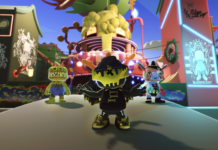I first saw Ridley Scott’s slightly overrated Gladiator in 2001, and I have to admit my teenage self became obsessed with gladiators by the film’s end. I bought books on gladiator history and ancient Roman culture, played gladiator games, and generally went through one of those phases all high school nerds find themselves in at some point. For me, gladiators were better than pirates, monkeys, ninjas and zombies combined. I still feel that way, in fact, and any game that shares that passion is worth checking out.
Unfortunately, the video game industry has skimmed over games set during in ancient Rome. An occasional gladiator title will come out, and it will usually disappoint. Outside of my all-time favorite game, Gladius (a turn-based gladiator RPG from Lucas Arts before one of their five-year, internal meltdowns), video games about ancient Rome are rarely good or even original.

But I’m willing to give Gods & Heroes: Rome Rising a chance. Developed originally by Perpetual Entertainment and now owned and developed by Heatwave Interactive, Gods & Heroes is an upcoming fantasy MMO set in the time of gladiators and Roman generals, supernatural beasts and evil Telchines, early Roman proto-gods. Gods & Heroes distinguishes itself from its few peers with a world immediately recognizable for fans of Roman mythology but wholly different from other MMOs.
All players start in the same place, washing up on Telchinos Island to begin their quest. Like any other MMO, players will journey on collection quests, fight monsters, and do all the typical MMO tasks. The classes—Soldier, Gladiator, Mystic, and Priest—all follow the familiar tank/DPS/support motifs. There are no other species besides humans, a design decision made to ensure the armor fits and looks right on the model. Between the character classes and gameplay style, Gods & Heroes should be no problem for players to jump into and play.

Where the game does mix things up are the support units. Each player can have up to four minions assisting them. More than just pets, these have different actions and abilities and are mostly capable of taking care of themselves and the rest of the group. They allow the game to be much more “solo friendly,” although they take on a new dimension in group instances. Up to five players can work together, meaning up to 25 units can be on-screen at once, and that’s pretty cool. There are 130 different minions, ranging from bland normal units to the supernatural.
Players will also have the traditional skill trees that you’d expect from an MMO; however, it does change with how players align themselves to a god. For example, the Soldier class can align themselves with Mars or Minerva. A Mars alignment will bring more DPS, while a Minerva alignment leads to a tanking play style. Quests will result from aligning to a god, as will special mythical minions.

One of the most interesting features in Gods & Heroes is the private personalized estate. Story goes that the player character is a famous retired Roman general, and upon returning home to his estate, he is attacked by the Telchines, who are killing the great heroes of Rome. While the game begins on the starter island, players will be able to return to their home. While it’s initially empty and ruined, players can rebuild their mansion, add a temple, shops, barracks, and more. These buildings can be placed anywhere on the estate to ultimately form a small town, with people walking around and working. By investing in their estates, players will receive bonuses for themselves and their minions as well as allow for blacksmiths to craft items and for auctions to get rare loot.
Interestingly, Heatwave has backtracked and repainted all of the art in the game. So while Perpetual had all the statuary and buildings in a standard marble white, Heatwave has chosen to colorfully paint everything, as if players were truly in ancient Rome. This is a small touch that should please history buffs.

The estate that players will have is not tied to the characters. Rather, it is linked to the account on a server, so when a player reaches the level 30 cap, they can create a new character and reap all the benefits of an upgraded estate. It’s an interesting method of getting players to build up an alternative character.
I’m not very impressed with how Gods & Heroes looks. It’s dated and—dare I say it—ugly, with muted colors and lots of scenery and enemy pop-ups. I know it’s a result of the game being developed back in 2008, but I wish it could look as good as Rift or even WoW. Considering Heatwave has done much to improve Gods & Heroes since Perpetual collapsed (adding more content and modifying previously faulty elements), I’m hoping they will be quick to offer texture packs and other visual upgrades. For now, it’s not a hot-looking game

Entering the MMO space is an incredibly difficult thing to do, and I applaud Heatwave Interactive in taking a chance with what was once a lost property. The estate element and the minions are new to the MMO marketplace and could influence many to give Gods & Heroes attention. Only time will tell if this game will gain traction for MMO players.










